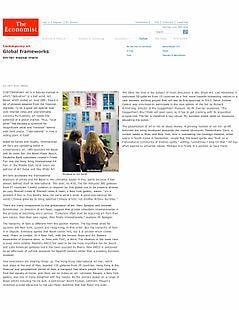
Global Frameworks: Art-fair musical chairs
CONTEMPORARY art is a futures market in which "derivative" is a bad word. Art Basel, which ended on June 20th, heard a lot of phrases adapted from the financial markets. To be a good bet against near-zero interest rates and unpredictable currency fluctuations, art needs the potential of a global market. Thus, "local artist" has become a synonym for insignificant artist and "national" damns with faint praise. "International" is now a selling point in itself.
Aided by banks and royalty, international art fairs are spreading belief in contemporary art. UBS sponsors Art Basel and its sister fair, Art Basel Miami Beach; Deutsche Bank subsidises London's Frieze Fair and the Hong Kong International Art Fair. In the Middle East, local rulers are patrons of Art Dubai and Abu Dhabi Art.
Art fairs accelerate the transnational exposure of artists and Art Basel is the unrivalled leader in this, partly because it has always defined itself as international. This year, its 41st, the fair featured 300 galleries from 37 countries. Careful curation is required for this global mix to be properly diverse. As Lucy Mitchell-Innes of Mitchell-Innes & Nash, a New York gallery, warns: "It's a problem if four or five booths have the same artist's work. A good international fair wants Chinese galleries to bring talented Chinese artists, not another Antony Gormley."
There are many components to the globalisation of art. Marc Spiegler and Annette Schönholzer, co-directors of Art Basel, suggest that private collections internationalise in the process of becoming more serious. "Collectors often start by acquiring art from their own nation, then their own region, then finally internationally," explains Mr Spiegler.
The hierarchy of fairs is different from the auction market. The top three cities for auctions are New York, London and Hong Kong, in that order. But the hierarchy of fairs is in dispute. Everyone agrees that Basel comes first, but it is unclear which comes next: Miami or London. Or if New York, with the Armory Show and Art Dealers Association of America show, or Paris with FIAC, is third. The situation in the lower tiers is even more volatile. Madrid's ARCO fair used to be the most important fair for South and Latin American galleries but it has been usurped by Miami. Now ARCO is perceived as an afternoon of cultural exposure for Spanish punters rather than a pressing business occasion.
Two newcomers are shaking things up. The Hong Kong International Art Fair, which took place at the end of May, boasted 155 galleries from 29 countries. Hong Kong is the financial and geographical centre of Asia, a transport hub where people from West and East feel equally at home, and there are no duties on art. Lehmann Maupin, a New York gallery, was one of many delighted with the results. As the primary dealer on a range of Asian artists including Do Ho Suh, a well-known South Korean, Lehmann Maupin's inventory proved attractive to the pan-Asian audience that had flown into town.
The other fair that is the subject of much discussion is Abu Dhabi Art. Last November it welcomed 50 galleries from 19 countries as a first move towards interesting visitors in a vast museum building project that will see its first openings in 2013. David Zwirner Gallery was convinced to participate in the next edition of the fair by Richard Armstrong, director of the Guggenheim Museum. As Mr Zwirner explained, "The Guggenheim Abu Dhabi will open soon, so it has to get cracking with its acquisition programme. The fair is therefore a key venue. My business model relies on museums educating the public."
The globalisation of art is not all about money. A growing number of not-for- profit biennials are being developed alongside the market structures. Massimiliano Gioni, a curator based in Milan and New York, who is overseeing the Gwangju biennial, which opens in South Korea in September, recalls that the avant-garde was "built on a transnational community of kindred spirits," adding, "sometimes I long for that." Art has often aspired to universal values. Perhaps it is finally in a position to have them.
